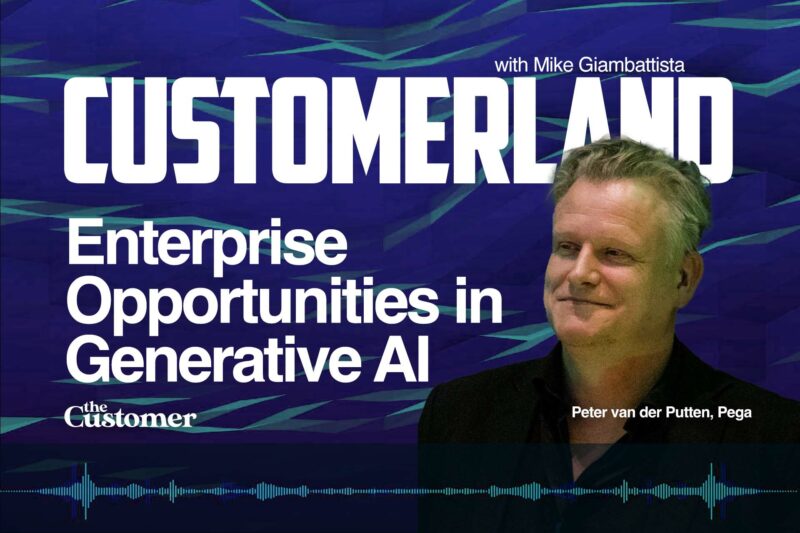Peter van der Putten is Director of Pega’s AI lab – which essentially means that he’s in charge of all of the various ways in which AI (and its derivatives) can be harnessed for the good of Pega’s huge, worldwide customer base. In this conversation, we cut through the hype and dive deep into the enterprise utility of AI – generative AI and conversational AI, specifically, and what the future holds for organizations that can intelligently deploy this revolutionary tech to enrich their customer relationships.
Not only is Peter extraordinarily well-versed on everything AI, but the conversation couldn’t have been more timely considering all of the confusion and anxiety around the topic at the moment.
 This episode is sponsored by the 2023 CRMC Conference. Learn more here.
This episode is sponsored by the 2023 CRMC Conference. Learn more here.
Full transcript below:
Mike Giambattista:
Peter van der Putin is director of Pega’s AI Lab, and I can’t think of a better person to be talking to at this moment in time about the crush of opinion frantic fear and everything that that the news cycles are spinning out on generative AI chat, G P t, and its successors. You know, are we all doomed? Is there, is there enterprise utility for this? So Peter has a, a, a deep understanding one of the technology and how it works, but I think as I understand your role at Pega, also a deep understanding of its utility. So, Peter, thanks for joining me. I really appreciate it.
Peter van der Putten:
Yeah, it’s awesome to be here.
Mike Giambattista:
So I have way more questions than our session will allow for, so but why don’t we start here? Why don’t we, if, if you would talk to us a little bit about your role at Pega and, and how you are involved in generative AI and, and what you’re doing with that notion.
Peter van der Putten:
No, absolutely. So I’m, like you said, I’m the director of the AI lab. So I’m pretty much the AI guy and, and Pega as a company we, we help our customers operate in a kind of in, in the world nowadays where we see a lot of change. And we, we help our clients to kind of react to that change by doing more, a better job at customer centric one-to-one marketing by translating moving from, say, product experiences to end-to-end customer journeys, but also by doing more, less, you know, like becoming more efficient, more effective. And how we do it. I, I quite often talk about the brain and the muscles. So on one side, we’re pretty good, pretty good, if I may say myself, <laugh>, in terms of automating processes and, and journeys and things like that. But on the other side we’re also focused on yeah, what we call AI power decisioning, or essentially how, how can we bring intelligence into, into a process or into an interaction to to achieve better goals. So, so that’s, that’s, as the director of the iLab, that’s what I’m focusing on, right? So how can we use that intelligence to to, to not just automate, but, you know, make interactions smarter and more, not just more efficient, but also more effective.
Mike Giambattista:
So, before we get into the question that everybody wants to know, is, is civilization civilization doomed because of this? We’re hoping for a positive answer on that, but you know, from from where I sit covering technology from the sidelines, AI has been in development and becoming more sophisticated over the past, I mean, since I became aware of its practical enterprise utility, maybe five or six years ago. And then what seems like literally yesterday chat, g p T comes out and the whole world is up in arms about its possibilities, potentials, and, you know plus and minus. But I’m interested in, in the process as it kind of unfolded at Pega, where you were employing AI-based concepts and technologies to, to what you seem to be doing now, I’m sure was something of a process. Can you, can you talk about that, what that’s looked like, say, over the past several years?
Peter van der Putten:
Yeah, absolutely. I mean so I, I kind of empathize with what you’re saying. Yeah. That on one side, AI’s AI has been around for age years, but on the flip side has gotten a lot more kind of attention nowadays. There’s also this wonderful there’s this kubot which goes a bit like and that, that we underestimate you know, we over sometimes we overestimate the impact of the new technology, the short term impact, but we underestimate the long term impact. And of course, AI has been through a number of summers and winters. But it takes a while for you know, for technology to really catch on in terms of not just just being out there, but actually having an application, right? So and to your question, you know, like we, we saw a lot of attention for things like what back then in the nineties, it was maybe called data mining and things like that.
People were doing knowledge discovery in databases, trying to find interesting patterns. But at some point the realization hit like, okay, but what are we going to do with all those insights? Yeah. So I think then artificial intelligence made a little bit of a transition more into what I would like to call maybe actionable intelligence. So how to how to make that intelligence actually actionable how to translate it into decisions real-time decisions that you would make, and when you’re dealing with a customer around what’s the best offer to show or what’s the resolution to a customer problem, and things like that. So that was maybe the evolution one where where we really double down on going from AI as an artificial intelligence to actionable intelligence. What we need, what we’re seeing now, of course is that we’re kind of moving from this brain that can optimize and that can decide to also using the creative powers of ai. And so how can we combine how can we yeah. Actually leverage AI’s ability to well, to become creative Yeah. To and becoming creative. Of course, it could, could mean a lot of things. Right now, it kind of materializes as a chat G P t, you know, that you can ask all kinds of questions, but obviously what a lot of companies are doing or where the real benefits are is when you look at particular use cases that you would develop on top of that creative technology.
Mike Giambattista:
I’m really interested in hearing how Pega will be using the generative AI capabilities that are, that are being developed right now. But, but I’m really intrigued by something you said, because it resonated with me. You know, that we tend to maybe overestimate the short term impact of technologies like this and underestimate the long term. Now, I’ve, I’ve heard this put a couple of different ways recently. One was that we’re, in terms of marketing, we’re kind of at the dancing cigarette box of what AI can do. You know, and the reference goes back to the early days of TV when the smartest thing you could do was to put a cigarette box on there and have somebody dance around inside of it. And that would get people’s attention. And, and, you know, as we all know, TV exploded into this huge visual medium, which just, you know, a billion other things has impacted us innumerable ways.
And someone else put it similarly and said that this is basically the refrigerator moment when, you know, yes, there are people out there who can, who can build a good refrigerator, but it was people like Coca-Cola and that day who said, look, what we can now do that we could never do before, and created an entire industry out of, out of some new technology hadn’t existed before. So the, there’s a question buried in there, and that is you know, the, the, the short term over-indexing of our excitement and fears is it’s being well played out in media, but the longer term, I’m really interested in what your thoughts on how that might look, 2, 3, 5, 10 years. Like, what are those things that you think are gonna change because of this technology?
Peter van der Putten:
Yeah, I think that’s an awesome question. And I think it’s good to maybe take a step back when you think about that. We have a variety of use cases in, in customer service in intelligent automation, but let’s take marketing here. I think what people also tend to forget if a new technology arrives that, you know, what, what is our goal? What is our goal in this particular context? And so what are we trying to do in, in, in marketing? And so and I, I think it’s quite healthy to, to, to, to think to think in terms of marketing concepts. For example let’s say we did some research and we found out that the majority of customers they’re convinced that companies are not doing what’s is, is, is not, are, are not doing what is in the best interest of the customer, but it’s primarily doing what’s right for the company.
Yeah. So, and of course that leads to irritation on behalf of the customer, right? Because if I open up my mobile banking app, I want my bank to understand that it’s Peter and not someone else, but also my real time context that I just dip my credit card just get blocked. That’s a different Peter than an hour ago. Yeah. Or ultimately, I have all kinds of moral expectations, even where I say, well, I, I expect the bank to do what’s right for me, not just what’s, what’s right for the bank. Yeah. So and and of course we a lot of organizations still have issues to kind of deliver on that because they’re kind of lacking that central brain where you would say but you would really not start with the, the marketing offer or the marketing campaign where, but where you actually start with the customer and look across all of the, the actions that you have, and think about what is the right thing to, to actually do here to deliver on, on all of those expectations, not just personalization towards the customer, but also the real time circumstance and the moral expectations that we have.
So I think ultimately that that should be the goal of ai Yeah. To provide that that relevant contextual experience. And I think what and then it becomes maybe also li little bit clearer because on one side you can imagine that, okay we’ve been talking about AI a lot, but ultimately where it can help here is to provide, let’s say, the optimization of AI than, let’s say the left brain of ai. They’re trying to figure out which messages customers are more likely to respond to which are more likely to be relevant for customers. And, and having the classical AI with your business rules, trying to figure out really what’s the right to do. And then on the flip side, yeah, where it can go is that if we can plug in if we use the right brain ai, let me call it like that for a brief moment, and a creative intelligence with AI to to keep feeding this brain with all kinds of interesting treatments actions experiences that could possibly relevant in a particular context.
So the left brain is matching the customer in the context to the right message, but the right brain will continuously come up with all kinds of interesting let’s say, interesting things to talk about, or also interesting ways to talk about the same thing. Yeah. And that’s, I think where the creative AI can can actually help a lot, but it’s all a means to an end. Yeah. So if new technology arrives where I want to go is then as short term people are thinking in terms of the, of, of the, of the technology as a goal. But ultimately, technology should be a means to an end, and the end should hear be here. Like, how can we provide more customer centric experiences to our, our customers? Yeah. So, and if, if you ask me to look in the glass bowl, where, where could we be a couple of years from now? Yeah. It will all be marching towards that, that particular goal. Yeah.
Sponsor Announcement:
This isn’t so much a sponsor message as it is an encouragement each year for the past 20 years or so, the world’s best marketers have been gathering in Chicago for two and a half days of high level learning and networking. It’s called crmc on my calendar. I’ve placed a hard hold on June 7th through the ninth so that I can be there and be a part of what’s about to happen in retail, in loyalty and in technology. You should be there too. You can learn more, and you can register in the link below this podcast, or you can go directly to the event [email protected]. That’s the crmc.com. I go to my fair share of events throughout the year. CRMC is my one can’t miss event of the year. I hope to see you there.
Mike Giambattista:
I like the way you framed that up. There’s a, there are left brain functionality and right brain functionality, but ultimate best case utility is when both of those are supporting one another for a, a particular outcome. Yep. and I also, I was looking at some of the notes here before we started this conversation, and then I think the and I don’t know whether this was Pega’s talking point, if you will but, but it’s the way it’s stated, leverage AI as a starting point, and generative AI gives low-code developers an infinite library of process and case templates. AI can provide a starting point, but we must the position to refine it, improvise it, and ultimately govern it. It, it seems like that, that kind of a statement, just, if you’ll just put that out there with no other context, does a lot to alleviate a lot of the anxiety that is in the media right now over the topic.
Peter van der Putten:
Yeah, absolutely. I, of course, everyone is thinking about hell, you know I can’t do, I, I can’t do this for you, right? So the, the 1960s movie where there’s an AI autonomously kind of talking to to a customer that that’s the way how we use che g p t to do or to do our homework or, or whatever. But I think in a lot of use cases will be use cases where there’s a human in the loop here, where there would be a marketer in the loop, huh. Where the marketer the marketer uses it as a creative tool to come up with all kinds of treatments for, for example, one of the use cases we’re working on is let’s say you have a particular, you know, next best action that you want to introduce around, I don’t know, it could be something very sales or marketing oriented, like ordering a cust customer a new platinum card.
But it could even be something which has nothing to do with selling, selling something to a customer, and more about how can the customer actually get more value out of the bank in this example, rather than the way around like warning them about expiring credit card points. Yeah. So, or nudging them that they can get money back from the government because they just put solar panels on their roof. Still, you know, the way you kind of entice customers to respond positively to such a message depends very much on how you, how you translate what kind of treatment you would use in that context. So an example that, that, that we use is to say, well, can you maybe use different persuasion styles? And so if you take that, that same let’s say that same next transaction treatment with the credit cards expiring or whatever, and then you could say, oh, you know, like you can make it more around social proof, you can make it more around reciprocity about liking and or so social proof would be you know, like did you know that last year 89% of our customers whatever spent all of their points on their credit card and your cards are about to expire, so please use them, eh, because that’s, that’s what they’re for.
That’s social proof versus reciprocity. Yeah. Or a liking could be well, you know, we really value our customers and, and, and we do know that sometimes there’s a time of giving back. Yeah. And our, our loyalty points are a way to give back to you as a valued customer. So yeah. Even though, even though it might be good for us, because it doesn’t co you know, we we’re saving money, if you’re not spending them, we really want you to spend, spend your points. Yeah. So, so basically we can tell the AI to say, wow, we have a, actually this particular yeah, this particular, let’s say marketing proposition. What are the different ways to communicate it to the customer and generate those variants? On the flip side, that, that drives even more of a need. If you have a, such an explosion of new treatments, eh, new ways to talk about to talk about particular, let’s say marketing proposition there will be an explosion, even bigger explosion of messages, right? So you, you do need a left brain than even more to figure out in that, that, you know, in those 50 milliseconds, when I open up my mobile banking app, what it is that, that we should be doing here,
Mike Giambattista:
I’m intrigued by of the, some of the subtleties that have, that have, I’ve kind of become aware of even in recent weeks. I know, you know, when you’re talking about the, the tone of messages and the kinds of messaging and even the cultural nuances that have to be taken into consideration at scale, that becomes a huge and daunting task. But generative ai, certain applications are, you know, they’ve, they’ve got, they’ve got a large language model that is so sophisticated now that, that it can, it can take cues from past communications and can communicate back to me in a language that it feels I will best receive, which is a pretty unique talent. And I know a lot of copywriters out there are a little bit scared for their jobs because of that, because that, that takes a, a lot of nuance, that takes a lot of perception to try and figure that out. But, but here it is happening. I mean I guess when I was first introduced to, to chat g p t, just to try out some things, we did some article composition on it. And to be really transparent, the articles, it, it generated the, the, the content. It was all true and correct, but it was as dry as a sweater there
Peter van der Putten:
Was. Exactly. It can get quite bland. Right. So
Mike Giambattista:
Incredibly bland.
Peter van der Putten:
Exactly. And so the, the trick here is, you know, trick the, the, the, well, yeah. The key thing here is that is actually prong to engineering as well, right? So plus evaluating the output. Yeah. So, and I think that’s maybe when you talk about how do rules shift how does the role of a content oriented marketer actually shift that might be actually in trying to figure out you know, how do I steer the AI to come up with to come up with good content, but also, we’ll like I said I don’t see, I don’t foresee that marketing use case in a way where there’s some you know, completely unconstrained AI that in the moment and actually also generates the particular text that’s going to be used for that offer probably with beforehand. There will be marketer who looks at who’s using creative AI to create like, lots of offer and treatment variants, right?
So, but it will, the marketer will do it in such a way where they’re applying their brains in terms of, Hey, what kind of what kind of treatment variants do I need here? I’m, am I going to use those chaldini principles for persuasion? Yeah. Because it is persuasion here at the issuer, or should I have more like different types of treatments? One which is more value oriented, one is more, let’s say price oriented. Yeah. And one maybe addressing more like younger audience. This, again, could be driven at the left brain, and the left brain could give you hints as a marketer where your coverage is a little bit thin, eh, to to maybe put it metaphorically, right. <Laugh>, but then so you, you’re still applying then your, your marketing brain to figure out, yeah, okay, but which way should I go? Right. And you are evaluating the let’s say the different pieces of copy that are being produced to, to, to see like, oh, I can use this one, but this one, you know, it’s, it’s really unusable. Let’s regenerate. Or let’s, let’s just simply ditch it.













